By Arthur Parker
If you were asked what the most proven combat optic in the world was, what would you say? If your answer was not the Trijicon ACOG, you answered wrong. Trijicon has been around since 1981, however, the beloved ACOG (Advanced Combat Optical Gunsight) was not introduced until 1987.
The ACOG is a fixed power optic that was originally only offered as a 4x with the first TA-01 model (Insert Picture 12). Since then, Trijicon has brought to market variants ranging from 1.5x all the way to 6x. Design and features have remained relatively unchanged since the TA-01, with the most noticeable change being the addition of fiber optics for daylight bright reticles. ACOG’s didn’t exactly take off immediately upon Trijicons unveiling.
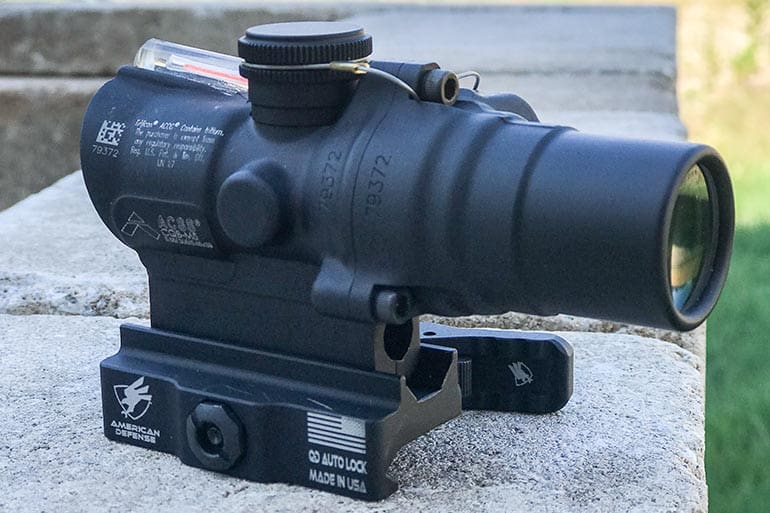
It wasn’t until 1991 and Operation Desert Storm where the US started to take notice and actually started to deploy them in combat theaters. The durability of these optics has been Trijicon’s most praised attribute, and was just what the military needed for a fighting rifle. The ACOG was far beyond anything of its time, and to this day it remains just as relevant as it was in 1991.
The use of a fixed 4X optic just made sense for over three decades. Since the ACOG’s creation, the vast majority of the United States’ conflicts have taken place in the mountainous middle east, with most enemy encounters occurring several hundred meters away. For this reason, the 4×32 models have been the most widely used optics in the US military.
What about when combat theaters evolve? When fighting occurs in more urban areas? Well Trijicon has an answer. Meet the TA-44-C mini ACOG.
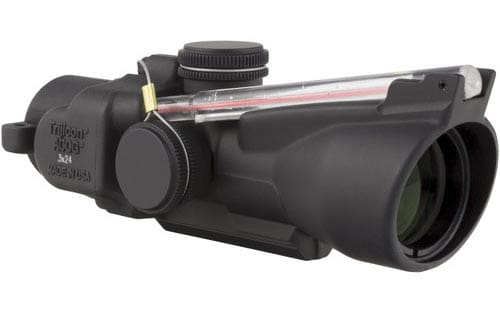
This 1.5×16 optic is remarkably compact at 4 inches long and 5.1 ounces in weight, with all the durability and reliability of its bigger brother. This one rests on an American Defense Manufacturing QD mount.
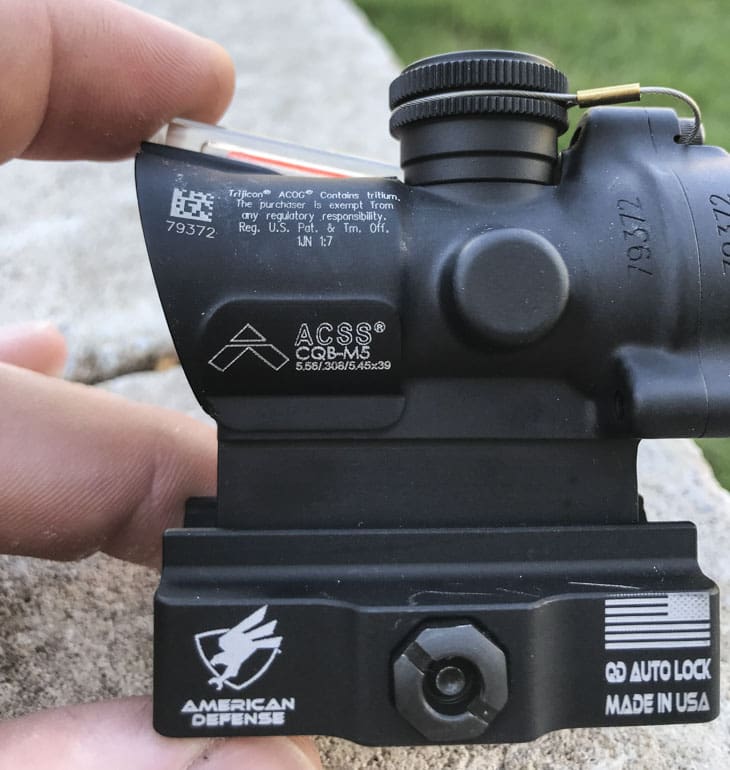
The body of the TA-44 is forged from 7075-T6 aluminum, which is the gold standard for a combat optic. The tube is then finished off with a matte black anodized finish that almost gives the appearance of a rubberized exterior (Insert Picture 2).
The lenses on the mini ACOG are multi-coated and offer light transmission and clarity that is second to none. I can say with confidence that this ACOG has the clearest glass I have ever seen on an optic.
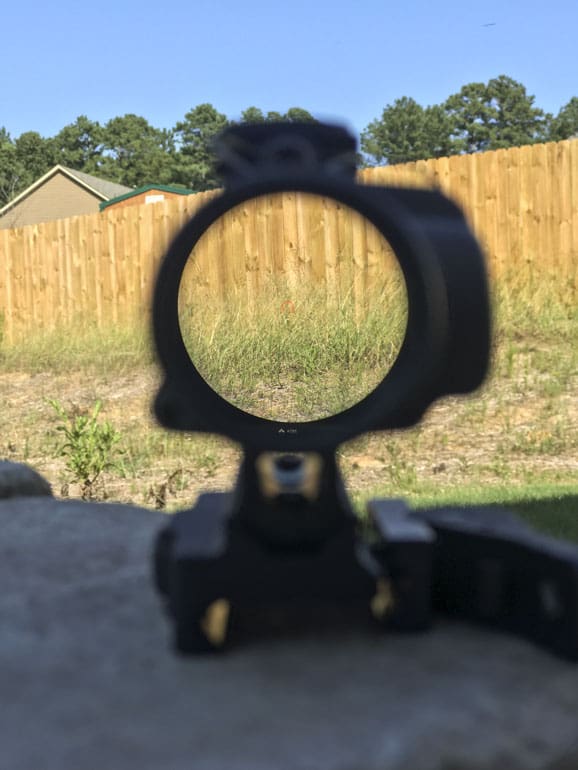
The advertised eye relief on the TA-44 is 2.4 inches, but it is much more forgiving than Trijicon gives it credit for. I was able to get equally good eye relief from two inches all the way out to over six inches. The trade-off you have to swallow for the forgiving eye relief is the field of view, or should I say lack thereof.
The 16 mm objective lens will give you a smaller field of view than other models (Insert Picture 5), but what do you expect from an ACOG this small? The windage and elevation turrets are both capped and tethered; a nice feature we’ve seen from Trijicon for decades.

I won’t give them too much credit as any optic intended for combat should feature that in my opinion. Adjustments on the TA-44 are ½ MOA per click and can be made easily by hand. Clicks are audible and tactile. No complaints in that department.
Trijicon offers several different reticle choices and colors for the TA-44 series, but I opted for the ACSS reticle with the red illumination. This specific model (TA44-C-400306) is only available through Primary Arms, due to the ACSS reticle being the work of Dimitri Mikroulis of Primary Arms.

For those who aren’t familiar with the ACSS reticle, it’s excellent. The Advanced Combat Sighting System reticle comes in several different shapes and sizes. This specific TA-44-C features the CQB-M5 version which we’ll be discussing here. However, you can find the ACSS in its most simplistic form in several red dots, as well as its most complex form in long range precision optics.
The CQB-M5 gives you a 2 MOA chevron in the center with 1.5 MOA and 1.2 MOA dots underneath. Encompassing all of this is a very large horseshoe. Underneath this horseshoe is a series of four horizontal ranging lines.
What’s amazing about this reticle is everything you can accomplish with it. First, it gives you the ability to account for bullet drop out to 500 yards. Second, it gives you the ability to range a target, based on the size of the average male being 5’10” and eighteen inches wide. Lastly, the ACSS provides a lead point on the outer edge of the horseshoe for a target moving 6.1 MPH (average running speed).
All of these capabilities are wrapped up in a surprisingly simple reticle. If you’re anything like me, when I first discovered the ACSS, you may doubt the reticle’s accuracy. However, from my testing, I found that the ranging and drop compensation features are spot-on and there are several videos out there supporting that fact.
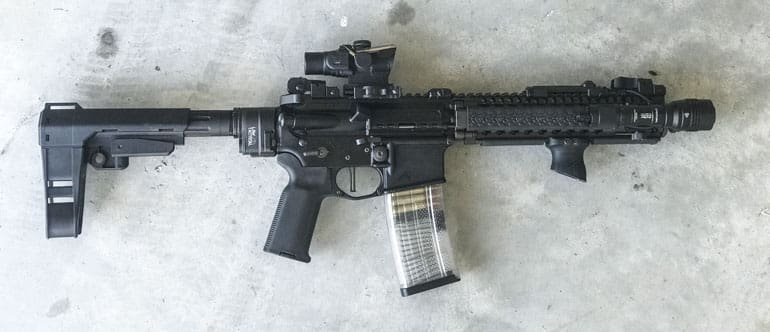
As good as the ACSS reticle is, in the TA-44, it does suffer from being incredibly small. The capabilities of the reticle are slightly overshadowed by the fact that using it takes more focus than an eye exam at 60 years old.
While shooting on the move, I used the TA-44 primarily how I use a red dot, and being only 1.5x, this worked out fine at close distances. The only time I could really use the reticle how it was intended, was when shooting off of a rest. Even that took quite a bit of squinting, however I was able to pick up the individual aiming points and easily make hits out to 300 yards.
The reticle illumination in this mini ACOG is perfect. Larger models have long suffered from being overly bright in direct sunlight and the go to remedy for this has long been to tape over part of the fiber optic. However, with the TA-44 having a much shorter fiber optic, I found that the reticle never got overly bright in sunny conditions.
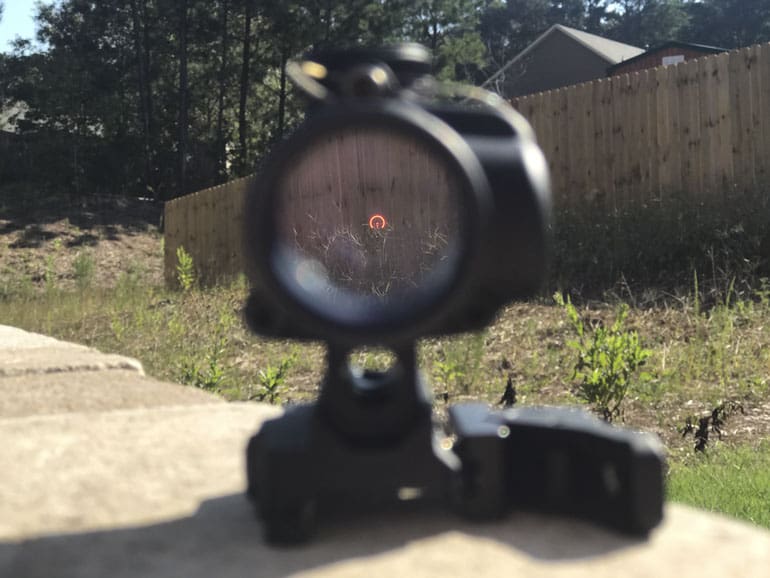
For when the lights go out, tritium has you covered. You won’t get the same brightness as you would through the fiber optic during the day, but the tritium illumination works perfectly in low light conditions when a super bright reticle isn’t necessary.
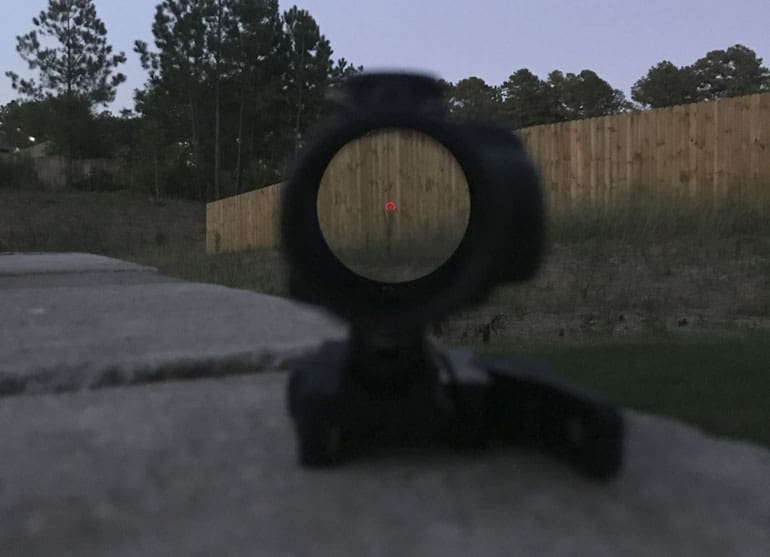
The TA-44 has an intuitive way about it in terms of illumination. It works better than any automatic adjusting reticles I’ve used and I honestly trust this ACOG to know what brightness level I need more than I trust my own eyes.
The TA-44-C takes first prize as my favorite optic. It’s rugged and seemingly bomb proof exterior has gained my respect and I am confident that this optic will endure any scenario it could be put through.
The fact that I never have to worry about batteries, while still getting brightness that you would only expect from a battery-powered optic is fantastic. The clarity of the glass is simply unbeatable. I would argue that Ray Charles could have made positive target identification through this glass.
I trust this optic as much as I trust the MK 18 in sits on, and that’s saying something
Specifications: Trijicon ACOG TA-44-C
Color: Black
Magnification: 1.5x
Illumination: Tritium/Fiber Optic
Eye Relief: 2.4 Inches
Adjustments: ½ MOA
Length: 4 Inches
Weight: 5.1 Ounces
Height: 2.1 Inches
Width: 1.6 Inches
Finish: Black Anodized
Field of View: 7.4 Degrees
MSRP: $1,213 ($820 at Primary Arms)
Ratings (out of five stars):
Quality * * * * *
Trijicon is known for making quality optics. The TA-44 is no exception. Ask anyone who owns one.
Durability * * * * *
Do I have to stop at five stars? This is a no brainer. Just look at the ACOG’s track record. It’s seen hard use in conflicts on every continent. There’s a reason the military just keeps getting more or them, and it’s not because they don’t like batteries.
Clarity * * * * *
As I said earlier, this is the clearest glass I’ve ever seen. Edge-to-edge clarity is consistent all the way around. This optic sees things clearer than my naked eye can.
Reticle * * * *
I can’t speak for the other reticles offered in the TA-44, but the ACSS is the Swiss Army Knife of reticles. It can do more than you’ll probably ever use it for. However, all this greatness is borderline useless due to how small it is in this optic. Shoot from the prone or off a rest and you’re good. If not, good luck.
Overall * * * * *
I can’t say enough good things about this optic. You get the legendary dependability of the ACOG with the size and weight of a red dot. No batteries needed. If you’ve been looking for a CQB optic, look no further.





I don’t know. The price of admission is just way too high for a glorified red dot. I just can’t justify it when there are so many alternatives now a days. Holoson, Vortex, Primary Arms….. The list goes on. Don’t get me wrong I like Uncle Sam to equip out boys with the best and they have proved their worth. It just doesn’t do anything for me personally that all these sub $200 optics do.
If you’re only shooting in a brightly lit and short range then sure, that's probably true. The extra $$$ you pay for good glass really only kicks in when the lighting is getting low or at extreme magnification.
Most of the extra $$$ here goes to being soldier/Marine proof. If you carry your rifle back and forth to the range in a case it pretty much eliminates all the ACOG’s advantages. Heck, you could burn thru like 6 Primary Arms red dots and still come out ahead since your life doesn’t depend on it. Unless you just like nice over engineered things, which is totally fine.
“The extra $$$ you pay for good glass really only kicks in when the lighting is getting low or at extreme magnification.”
This is a 1.5x optic, so high magnification isn’t an issue, and it’s not really collecting light in low light situations. As long as the glass isn’t absolute crap, it’ll do the job.
Weapon shown is an SBR. How does this affect aim points? Seems like the drop would be different from a 16″ or 20″ bbl, likewise the lead point for moving targets.
I was researching barrel lengths impact on poa,poi just this morning.
The drop is not enough to matter unless you are wanting bullseye hits at 300 yards and beyond.
https://www.everydaymarksman.co/equipment/barrel-length-trajectory/
Kind of curious what the author’s credentials are for writing this review. Does he have experience? If so where and what kind?
And how does this Optics stack up against other holographic sights? Is it faster acquisition then say a dot soght or a EOTech?
And is it appreciably better for the 800 to $1,200 price?
I haven’t shot The Acog, but I shot lots of other ones. The EOTech and a Sig Romeo 5 do a more than adequate job for a fraction of the ACOG price.
Experience requirements to write a TTAG review on an optic: test it thoroughly, fairly compare it to other offerings, and spend a few hours compiling notes, images, and drafting an article. What exactly was missing from this review that you think would have been remedied by X hours/years/specific type more experience?
I’ll say it again, for the 69th time, if something is factually inaccurate, and/or if you think you have more accurate data to present, write an article yourself. When I see your name as the author of an article I’ll concede some respect for taking the time to showcase your time/energy/experience. Until then, you’re just whining about a free service.
I’m a big fan of the various ACSS reticles, but the TA44 is best left in its standard Trijicon Circle & Dot configuration. With only a 1.5x magnification I think that the ACSS reticle is just too small. Even though they are really nice I haven’t been able to talk myself into a TA44. A red dot is just so much cheaper. If you don’t mind the cost the TA44 is a great little optic.
If you want one of the smaller and lighter ACOG’s I really think the TA33 is the best option. It’s a 3x and has great eye relief. The field of view is rather small, but with both eyes open it is still reasonably fast up close, while still having enough magnification to help make shots at 3-400 yards.
I also have a TA11 3.5x and it has good eye relief and a large field of view, it’s also pretty large and heavy. I like it, but a Vortex Razor HD 1-6 would be a more versatile scope and if you are going to spend ACOG money it might be worth waiting a few more months to save the $$. A 1-6x just gives you a lot more capability.
I’m not a big fan of the TA31 4x which is the standard military optic for the Army and Marines. It’s size and weight is good and the field of view is fantastic, but it’s eye relief sucks.
Question for those of you who have experience in this:
I’ve never shot a 1.5x optic before and have often wondered what’s the point? It’s my understanding that a true 1x optical scope lets you shoot with both eyes open like a red dot, and a magnified scope helps you see what you’re shooting at better (with one eye closed), but what advantages are there with such a low magnification? There must be a good reason for it- Steyr Aug’s often have a 1.5x scope too.
I’ve shot an AUG with that setup and I agree. It’s not as good as a 4x for 100+yd shots and not as good as a 1x red-dot for closer work. I’d rather pick one or the other and accept the lost capability.
On a similar thought…I tried flip-to-side magnifiers for 1x red dots and that quickly proved stupid. It’s a bunch of extra weight, parts flopping around, and doesn’t really provide a 3-4x capability as well as a dedicated 3-4x optic. The red dot center beam is also magnified so it blurs the dot around the target, even on high-end red dots (Aimpoint, EoTech). I’d rather mount a 1-4x scope for less weight, fewer moving parts, and less crap literally flopping around on an AR’s rail.
The worst thing about the AUG 1.5x is the doughnut reticle. It’s huge. At 300m a 1.8m tall person will just fit inside it. If you google ‘Steyr 1.5x range estimation’ you can find a picture of the ranging diagram. If it had a crosshair inside the circle it would have been a lot more useable. Back in 1977 it would have been a great combination.
ACOG? There’s an old saying…….Save up your money to buy a rifle and scope. Then go out and buy the best optics out there. Buy your rifle with whatever $$ is left over.
I didn’t appreciate optics until I acquired a Swarovski 6x scope! And I already had Zeiss and Leupold. This was back in the day when all I had were hunting rigs. Then I got an AR, then a few more. My scope worked OK. Finally popped for the ACOG. It’s head and shoulders better than anything I could have put on an AR. Better how? Trijicon’s customer service is the best. #1. Clarity,…..pretty much everything. Mine has the red chevron and ballistic lines for 5.56, 55 grn bullet.
My first thought was to just notate the settings per each rifle and since I can’t shoot two at once I’d swap the scope. Well heck. Just bought a second ACOG. This one has ballistic settings for the 556 but has the amber horseshoe. Both ACOGs are 4×32. Both I added flash kill lenses.
You can rationalize all you want but with optics you get what you pay for. Plenty of rifles these days shoot sub MOA. My $3k Cobalt Kinetics is more accurate than a $500 S&W but not 6x better! Amazing what you can get for $500. Seriously. But optics? Ask any Afghan or Iraq combat vet. And you can’t surmise that because you’re just hunting you won’t have to be too concerned with durability. Ask any hunter whose rifle was dropped onto granite or had a horse roll over on it. ACOG scopes, heck Trijicon, the best! Plus with the ballistic reticle it’s a great deal for hunting. You can use the 556 or 762 reticle on anything you’re shooting, any caliber, any weight bullet. Just do some homework to get built in Kentucky windage.
BTW…….I’ve got a couple BSA scopes you can have for $50 each. POS Chinese junk. Lifetime warranty also.
Oh! Yes. You can mount an RMR onto any ACOG. Why? For example my first antelope? I was all set to make that 600 yd shot. Accurate 25/06. Leupold 3×10 scope. All the ballistic dope printed and taped to the butt stock. Well I shot the antelope at 10 yards!
One more thing. I worked as an RSO at my old club in CA ( then I moved to the United States)
Can’t tell you how many times I heard guys cussing because they either couldn’t get their $2000 rifle sighted in or their $2000 rifle wouldn’t shoot accurately. A $2000 rifle with a $200 scope. I’d carry a spare 4x Leupold in my range bag. I’d let them swap it out just to see what happened. Guess what!! Problem solved. Not such a bad rifle after all.
Lastly there’s an old Swiss saying…….pay for quality and you only cry once
I run the TA-31 4×32 with the BAC, with the BAC Target acquisition is excellent when you shoot both eyes open. And reliability is simply not a factor. The Aimpoint is a good piece but not as near as nice if your target is beyond a hundred meters. When I bought my the E-O techs were having serious issues with the battery compartments, at one point DOD pulled them until they could get them right. I use to work in police supply, and I do understand EO Tech has gotten the bugs out, but Trijicon has a level of QC and reliability that is unmatched. Are the worth the bucks? It’s up to the buyer. Some of the new stuff, Sig, Leopold and Vortex are worth considering too.
The Trijicon TR-24 is a great sight and sits on my favorite AR. It zooms from 1-4 power and is tritium powered, even though the tritium is really only useful in almost complete darkness. The scope is very durable. I have a friend who used his for several years in three gun and he used to literally throw his rifle around the range. The scope survived real well and I was impressed with it so I bought one.
I have a green tritium RMR combo variant ACOG that I got at the time I was setting up my AR. I love it. I used red dots in the Army and always wanted a green dot type. For my .300 I am going with a cheap red dot and fixed sights with a nice big ass WML that is IR capable. Because you never know when you might need to use that GPNVG.